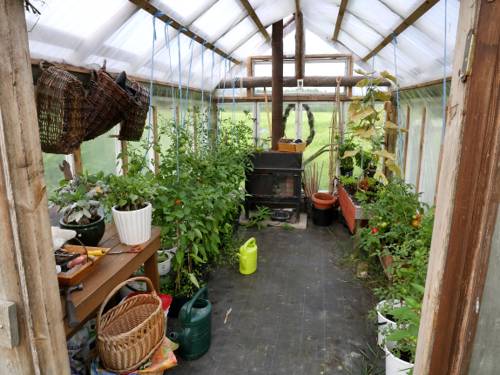
FAQ About Indoor Greenhouse Kit Setup

What is an indoor greenhouse kit?
An indoor greenhouse kit is a set of tools and materials designed to help you cultivate plants indoors. These kits typically include a small frame or structure that can hold pots or trays of plants, a transparent cover or panels to trap humidity and warmth, and often a lighting system to provide sufficient light for photosynthesis. These kits allow for growing plants year-round without depending on external weather conditions.

What are the benefits of using an indoor greenhouse kit?
Indoor greenhouse kits offer several benefits, including the ability to grow plants year-round, independent of outdoor weather conditions. They can help create an ideal growth environment by maintaining consistent temperature, humidity, and light levels. This controlled environment can result in healthier plants with better yields. Additionally, indoor greenhouses can be used to protect plants from pests and diseases, offering a more sustainable way to cultivate a variety of plants.

How do I choose the right indoor greenhouse kit for my needs?
Choosing the right indoor greenhouse kit depends on your specific needs and space. Consider factors such as the available space in your home, the types of plants you wish to grow, and your budget. Look for kits that provide adequate light, temperature, and humidity control for your chosen plants. Also, check if the kit includes necessary accessories like plant trays, grow lights, and ventilation systems to support healthy plant growth.

Can I grow vegetables in an indoor greenhouse kit?
Yes, you can grow a wide variety of vegetables in an indoor greenhouse kit. Many kits are specifically designed to accommodate edible plants. Leafy greens, herbs, and some dwarf varieties of vegetables like cherry tomatoes and peppers are particularly well-suited for indoor cultivation. The key is to ensure they get enough light and are watered and fertilized appropriately.

What types of plants can be grown in an indoor greenhouse?
Indoor greenhouses are versatile and can support a range of plant types. Common choices include herbs, such as basil, thyme, and oregano; vegetables like lettuce, spinach, and radishes; and decorative houseplants including succulents, orchids, and ferns. The variety you can grow largely depends on the conditions you can provide, such as light, temperature, and humidity.

Do indoor greenhouse kits require special lighting?
Yes, most indoor greenhouse kits require supplemental lighting, as natural indoor light may not be sufficient for plant growth. LED grow lights are commonly used because they are energy-efficient and can be customized to emit specific wavelengths beneficial for plant growth. It's important to use lights that mimic the natural spectrum of sunlight to support photosynthesis and encourage healthy plant development.

How do I maintain humidity levels in an indoor greenhouse kit?
Maintaining the right humidity levels is crucial for plant health in an indoor greenhouse. You can use a hygrometer to monitor humidity and a humidifier or a misting bottle to increase moisture levels when necessary. Some kits come with built-in humidification systems. Ensuring proper ventilation also helps regulate humidity, preventing mold and mildew growth.

What are the common issues faced when using an indoor greenhouse kit?
Common issues include pest infestations, mold growth due to high humidity, and inadequate lighting. Overwatering can also lead to root rot. It's important to regularly monitor plant health and environmental conditions, adjust watering schedules, and ensure proper airflow. Enclosing an area may also increase temperature, requiring attention to prevent overheating.

How often should I water plants in an indoor greenhouse kit?
Watering frequency depends on the plant species, the type of soil, and the overall climate within the greenhouse. Generally, plants should be watered when the top inch of soil feels dry. It’s essential to avoid overwatering, which can lead to root rot. Consider using pots with drainage holes and a well-draining soil mix to prevent waterlogging.

Can I use an indoor greenhouse kit in an apartment with limited space?
Yes, many indoor greenhouse kits are designed with compact footprints to fit in small spaces, making them ideal for apartments. Vertical designs and stackable shelves increase the capacity to grow plants in limited space. Before purchasing, measure your available space and choose a kit that aligns with your living area and aesthetic preferences.

How can I ensure adequate ventilation in my indoor greenhouse?
Adequate ventilation is crucial to preventing mold, diseases, and overheating in an indoor greenhouse. Make sure to open vents or use small fans to allow air circulation. Some greenhouse kits come with built-in ventilation systems. Consistently monitoring humidity and temperature helps to adjust ventilation settings accordingly.

Is it necessary to fertilize plants in an indoor greenhouse kit?
Fertilizing plants in an indoor greenhouse is often necessary because pots limit the natural replenishment of nutrients that occurs in a garden. Use a balanced, water-soluble fertilizer appropriate for the specific plant types you’re growing. Fertilize during growth periods as needed, and follow the instructions on the fertilizer label to avoid over-fertilizing, which can harm the plants.

What should I do if pests appear in my indoor greenhouse?
If you notice pests in your indoor greenhouse, first identify the type of pest and the extent of the infestation. Non-toxic options, such as insecticidal soap or neem oil, can be effective for controlling pests. Regular inspection and maintaining cleanliness can help prevent pest problems. Introducing beneficial insects like ladybugs can also help manage pest populations naturally.

Can I grow flowers in an indoor greenhouse kit?
Yes, many types of flowers can thrive in an indoor greenhouse kit. Species such as orchids, African violets, and peace lilies are popular choices. The key to successful flower cultivation indoors is providing adequate light, nutrients, and maintaining suitable temperature and humidity levels.

How can I optimize the growth conditions in an indoor greenhouse?
To optimize growth conditions, ensure your indoor greenhouse has adequate light, maintain consistent temperature and humidity levels, and use quality soil or growing mediums. Regularly monitoring and adjusting these factors based on your plant's needs will help promote healthy growth. Automated systems for lighting and humidity can help maintain consistent conditions without constant manual intervention.

Are there specific soil requirements for an indoor greenhouse kit?
Soil requirements vary depending on the plants you intend to grow. For most indoor plants, a well-draining potting mix works well. Some plants may require specific pH levels or nutrient compositions, so it's essential to research the needs of the plants you’re planning to cultivate. You may consider using soilless growing mediums like peat moss or coconut coir for certain plants.

What tools are necessary for setting up an indoor greenhouse kit?
Setting up an indoor greenhouse kit typically requires tools such as pots or planters, a watering can, a hygrometer for measuring humidity, and possibly a thermometer for temperature monitoring. Depending on your kit, you might also need LED grow lights, a timer for lighting, and fans for ventilation. It's crucial to read the setup instructions of your kit to understand the specific tools required.

How long does it take to set up an indoor greenhouse kit?
The time it takes to set up an indoor greenhouse kit can vary depending on the complexity of the kit and your familiarity with assembling such products. Basic kits can take as little as a couple of hours, whereas more complex installations involving lighting and electronic controls may take up to a day. Always follow the provided instructions carefully to ensure safe and effective assembly.

Can an indoor greenhouse kit help in propagating plants?
Yes, an indoor greenhouse kit can be excellent for propagating plants. It provides a controlled environment that can enhance the sprouting of seeds and rooting of cuttings. High humidity, adequate warmth, and constant light are essential factors in successful propagation, all of which can be well managed within an indoor greenhouse.

What should I consider when positioning my indoor greenhouse kit?
When positioning your indoor greenhouse kit, consider factors such as light availability, temperature stability, and ease of access. Placing the kit near a window can help maximize natural light, but ensure it doesn't lead to excessive heat. Avoid positions near radiators or drafts which could affect temperature control. Accessibility is important for routine care like watering and cleaning.
